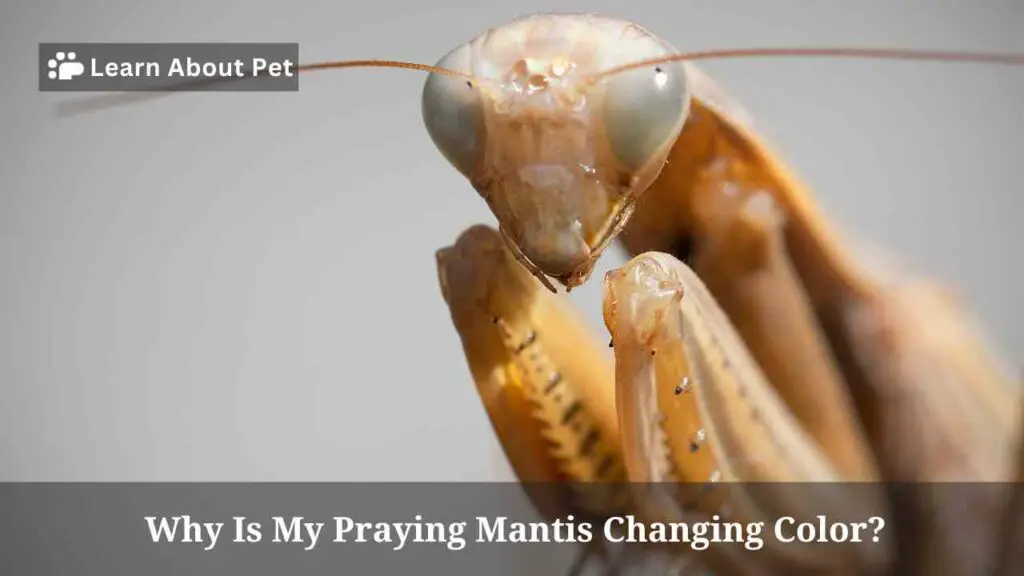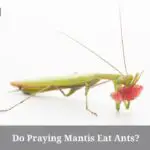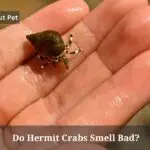Praying mantis are one of the fascinating pets known for their cryptice behaviors and unique physical features. One thing that pet owners often ask about is praying mantids changing color as their capability as a form of camouflage. However, it is still a matter of debate whether praying mantises can change color like chameleons or just change color in subtle ways.
Why is my praying mantis changing color? Entomologists who have studied mantises have observed that some mantis species do actually change color, with several adaptation factors in the mantis, such as temperature, light intensity, and humidity. Praying mantis can change color from green to brown or vice versa.
The color change occurs after molting, and occurs gradually over several days. This ability is not a quick camouflage.

There are still many people who don’t really understand that the praying mantis has the ability to change color, but only with specific explanations. Let’s discuss it in this article.
Why Is My Praying Mantis Changing Color?
Do Praying Mantises Change Color? Yes, they do. Praying mantis changes color from green to brown or brown to green, which helps them to blend with their environment.
An important note regarding color changes is that they do not occur instantly like chameleons, but they adapt to their environment. It takes time to change color and occurs after molting.
Unlike chameleons, which can instantly change body color according to the place they are standing. But mantises have several factors for color adaptations, such as humidity, temperature, and light intensity.
Do Praying Mantis Have The Ability To Change Colors?
Yes, praying mantis have a change color ability to blend in with their habitat, but not an instant transformation. Praying mantis can only change color after the molting process and takes several days to occur.
Mantis change their color depending on its habitat color. If the surroundings are green, mantis will turn to green, and if it is brown, mantis will turn brown.
Praying mantis changing color ability cannot be compared to chameleon. Praying mantis can only change subtle shades according to their environment, but chameleons can change color according to their position as an act of camouflage.
What Does It Mean When A Praying Mantis Is Brown?
Praying mantis turn brown when they have gone through a transitional phase, known as molting, because mantis try to blend into a new environment. Praying mantis take several days to change their color and tend to blend in with their environment.
Studies have shown that when the brown mantis is in an area of green vegetation, the mantis begins to change to a green color to blend in.
Color changes must occur through molting and depend on their development. The same has happened with green mantises that moved to brown vegetation.
If your pet mantis was initially green and turned brown, check for several factors, such as temperature or light intensity. There is a possibility that praying mantis changing color each time they adapt to their new habitat. Also check how the mantis behaves after molting.
If there are no problems, the mantis changes color because it wants to blend with its habitat.
How Do You Tell If A Mantis Is Molting Or Dead?
The praying mantis will molt between 6-10 times throughout its life. Each molting mantis will get out of their old exoskeleton and harden the new one. Praying mantis molting signs look like the mantis is dying, but it’s not.
Praying mantis will be lethargic, make erratic movements, and hang upside down in preparation for molting.
Praying mantis take several days to molt, and their bodies will lie still until they slowly emerge from their old skin. After the mantis has finished molting, they will carry out their activities as usual.
To ensure the mantis dies or molts, you can see whether there are any physical changes during molting. Any physical deformities are mismolt, and can cause a mantis to die soon. Mantis will appear to have bent body parts, broken legs, and a curved body.
In What Ways Can Praying Mantises Die?
There are many possibilities for praying mantis deaths apart from their lifespan. Some common praying mantises causes of death are injury, disease, and predation. Sometimes praying mantises will die after reproducing, because female mantis will consume the male after mating.
Poor handling when the praying mantis becomes a pet can also be a factor in the praying mantis dying beyond its lifespan. Mantis depend on humidity and hydration. If their habitat is too dry, and becomes dehydrated, the mantis will not be able to survive.
The praying mantis is dead because their natural enemies can kill them, or parasites that consume mantis from the inside out. Praying mantises can also die from infections or complications during their development. If mantises live around water, they can suffocate when they drown.
How Do Praying Mantis Die?
Praying mantis has many possibilities to die. These possibilities are mantis getting preyed on by reptiles, birds, amphibians, small mammals, or other arthropods. Mantis can die from infection by bacterial, viral, fungal, and other microbial pathogens.
When there is no access to food and drink for mantis, they can experience starvation or dehydration.
Praying mantises can die from mismolt or complications as they grow. Mismolt will cause praying mantis to experience physical deformities, and can lead to death. Some other common causes are old age or interaction with humans.
If praying mantis live in a place that does not have proper humidity or hydration, they can dry out and lead to death.
Can A Praying Mantis Play Dead?
Big nymphs and adult mantis females adopt thanatosis when they feel threatened by the predator. Adult male mantis do not play dead but prefer to run or fly away. Some mantis species will hide or play dead to avoid being caught by humans or predators.
Try checking whether you have a male or female praying mantis, because female mantis are more capable of playing dead. It’s essential to be careful when having a mantis in a cage, whether the praying mantis is playing dead or actually dying.
Sometimes, adult male mantis also play dead to avoid cannibalism after mating. Mantis can play death if the situation asks for it.
How Do I Know When My Mantis Will Die?
A sign of a dying mantis is a change in color to brown. The praying mantis is sick due to infection or dying will have brown or black spots.
The brown color of a dying mantis will be different from when a praying mantis turns brown to blend with their environment. A mantis that has an infection or has parasites in its body will change color because its body has a problem due to the effects of the parasite.
Another sign of a dying mantis is refusing to eat and being lethargic. Mantis will enter a fasting phase before they molt. Dying mantis will not move much and does not look for a special place to hang upside down.
The brown discoloration becomes increasingly disappear, and sometimes it will turn black.
Why Does A Praying Mantis Turn Brown?
HELP!!! MANTIS TURNING BROWN. That’s a common reaction when new pet mantis owners find out there is a color difference in their pet. But don’t worry, we will give several possibilities as to why mantis can change color to brown.
| Mantis turning brown possibilities | Explanation |
| Becomes brown all over their body | Praying mantises change color after changing their skin as a form of adaptation to their surrounding habitat |
| Brown feces spots | One indication of mantis is getting sick |
| Brown spots appearing on the mantis | Normal coloring |
| Brown spots getting darker or turning black | There’s an issue on your mantis, and mantis needs medical attention |
| Black spots | Indications are that the mantis has parasites or fungal infection |
Mantis have the ability to morph their color from green to brown or several color variations as they adapt to their environment. However, if the brown color changes to black, immediately have your pet checked because there are indications that the praying mantis is infected with parasites or has an infection.
Do Male Praying Mantis Turn Brown?
Adult mantis males retain their stick-like body configuration and brown color like when they were nymphs, while females will have bigger bodies to maximize egg production and have a green body color to mimic a leaf.
Several mantis species have a dominant brown color, such as the male Carolina mantis, which always has a grayish-brown color with green legs.
Both male and female mantis have the possibility to change color to brown depending on where they live.
But most female mantis will stay in their green color to make it easier for them to blend with the surrounding leaves or vegetation and avoid the many predators around them.
Final Verdict
Praying mantis has the ability to change color from brown to green or vice versa. Mantis will molt and change their color to blend with its environment. The time it takes for mantises to change color is waiting for them to shed their old skin. The molting process evolution takes several days.
There are several possibilities for the color of the mantis turning brown that you need to be aware of, such as fungal infections or parasites.
If you notice a change in the color of your mantis from brown spots to black, then immediately have your mantis checked to see whether they have a severe condition.

Welcome to Learn About Pet. My name is Rajkumar Ravichandran and I love all pets, travel, and amazing food. I write about my passion and personal experience caring for multiple pets in this blog! ❤️
Post Disclaimer
DISCLAIMER: THIS BLOG OR WEBSITE, "Learn About Pet", DOES NOT PROVIDE YOU WITH MEDICAL ADVICE AND IS NOT A SUBSTITUTE FOR MEDICAL ADVICE. ALWAYS GET IN TOUCH WITH YOUR PERSONAL VETERINARIAN AND USE INFORMATION HERE AS GENERAL ADVICE.
The information, including but not limited to, text, graphics, images and other material contained on this website are for informational purposes only. No material on this site is intended to be a substitute for professional veterinary advice, food recommendation, diagnosis, or treatment. Always seek the advice of your veterinarian or other qualified health care provider with any questions you may have regarding a medical condition or for pet food related questions.







